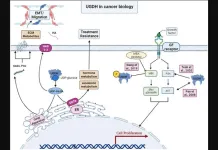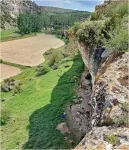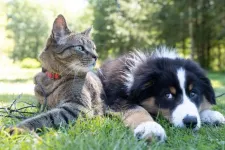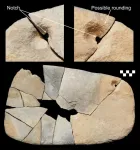(Press-News.org) Contacts:
David Hosansky, UCAR/NCAR Manager of Media Relations
hosansky@ucar.edu
720-470-2073
Audrey Merket, UCAR/NCAR Science Writer and Public Information Officer
amerket@ucar.edu
303-497-8293
Simultaneous outbreaks of large wildfires will become more frequent in the Western United States this century as the climate warms, putting major strains on efforts to fight fires, new research shows.
The new study, led by scientists at the National Center for Atmospheric Research (NCAR), focused on wildfires of 1,000 acres or larger. It found that wildfire seasons in which several such blazes burn concurrently will become more common, with the most severe seasons becoming at least twice as frequent by the end of this century.
The research was funded by the U.S. National Science Foundation, which is NCAR’s sponsor, and by the U.S. Department of Energy.
“Higher temperatures and drier conditions will greatly increase the risk of simultaneous wildfires throughout the West,” said NCAR scientist Seth McGinnis, the lead author of the study. “The worst seasons for simultaneous fires are the ones that are going to increase the most in the future.”
While other research has focused on the risk of more frequent and larger fires in a changing climate, the study tackles the problem from a different angle: what is the impact of climate change on fires that burn at the same time?
This is a critical question because simultaneous wildfires generally require more firefighting resources than a single large blaze. Multiple fires have more perimeter for firefighters to contain than an individual fire that burns the same area, and firefighting agencies in different regions cannot share their resources if they are facing a number of major fires burning at the same time.
“Simultaneous fires are a bigger challenge to manage than a number of fires burning one after another,” McGinnis said. “When fires are burning simultaneously, they put more strain on resources.”
The study appeared in the International Journal of Wildland Fire. It was co-authored by scientists from the University of Washington and the Oak Ridge Institute for Science and Education.
More simultaneous blazes across all Western regions
The number of large wildfires and the size of burned areas has increased in recent decades in the Western United States, with previous research showing that climate change is at least partly responsible. Since it is more expensive to fight multiple fires than concentrating resources on a single large blaze, McGinnis and his co-authors wanted to determine the future risk of simultaneous fires, addressing the issue in a way that would be most useful for firefighting operations.
The scientists began their analysis by drawing on observations of fires that burned in recent decades across the Western United States, dividing the blazes into regions, known as Geographic Area Coordination Centers, that are used for many fire management decisions. They correlated the fires with observations of atmospheric conditions, including temperature, precipitation, humidity, and surface winds.
The research team then simulated how those conditions will change as the climate warms this century. To do so, they turned to a set of advanced regional and global climate models, including simulations from the NCAR-Wyoming Supercomputing Center. By applying statistical techniques to the resulting simulations, the scientists were able to infer the risk of simultaneous wildfires in Geographic Area Coordination Centers across the West.
The results showed a steady increase in simultaneous fires across all regions of the West throughout this century, with more blazes burning in both relatively moderate and severe seasons. The trend was particularly pronounced for the most severe wildfire seasons — those that currently occur only every 10 years on average. In the future, such seasons may be expected to occur at least twice as often, and up to nearly five times per decade in the northern Rocky Mountains, which was the most affected region.
In addition, as hot and dry conditions become more conducive for wildfires, the peak seasons for simultaneous blazes in various regions will become as much as several weeks longer by the end of the century. This can be critically important for firefighting, since crews and equipment are often moved around the country (or even between the United States and other nations, such as Australia) to fight fires as different regions undergo their own peak seasons.
The study assumed that society would emit high amounts of greenhouse gases into the atmosphere in the future, a scenario known as RCP 8.5. However, even if society were to reduce greenhouse gas emissions, the authors said that would make little difference through mid-century, which is about as far out as policy makers would plan for.
McGinnis said decision-makers can take steps to manage the future risk and impact of simultaneous fires. These range from thinning forests and conducting prescribed burns to increasing firefighting crews and equipment. Such policies, however, can take a number of years to implement, and the strain on resources created by simultaneous fires can affect the ability to conduct prescribed burns and pursue other preventative action.
“We designed this study to be operationally relevant,” McGinnis said. “The findings about long-term trends can be useful to policy makers to inform their decisions on what to do on longer-term policy questions.”
This material is based upon work supported by the National Center for Atmospheric Research, a major facility sponsored by the National Science Foundation and managed by the University Corporation for Atmospheric Research. Any opinions, findings and conclusions or recommendations expressed in this material do not necessarily reflect the views of the National Science Foundation.
About the article
Title: “Future regional increases in simultaneous large Western USA wildfires”
Authors: Seth McGinnis, Lee Kessenich, Linda Mearns, Alison Cullen, Harry Podschwit, and Melissa Bukovsky
Journal: International Journal of Wildland Fire
On the web: news.ucar.edu
On X: @NCAR_Science
END
Simultaneous large wildfires will increase in Western U.S.
Trend threatens to stretch firefighting resources
2023-10-04
ELSE PRESS RELEASES FROM THIS DATE:
New UCF technology could reduce lag, improve reliability of online gaming, meetings
2023-10-04
Whether you’re battling foes in a virtual arena or collaborating with colleagues across the globe, lag-induced disruptions can be a major hindrance to seamless communication and immersive experiences.
That’s why researchers with the University of Central Florida’s College of Optics and Photonics (CREOL) and the University of California, Los Angeles, have developed new technology to make data transfer over optical fiber communication faster and more efficient.
Their new development, a novel class of optical modulators, is detailed in a new study published recently in the journal Nature Communications. Modulators can be thought of as like a light switch that controls certain ...
Rice alum Louis Brus awarded Nobel Prize in Chemistry
2023-10-04
Rice University alumnus Louis Brus (’65) has been awarded the Nobel Prize in Chemistry for the “discovery and development of quantum dots,” nanosized particles with unique properties “that now spread their light from television screens and LED lamps,” according to a Royal Swedish Academy of Sciences announcement today.
Brus, who started his undergraduate education at Rice in 1961, shares the distinction with Moungi Bawendi and Alexei Ekimov. Their work has been crucial to the development of nanotechnology, which has helped drive major computing ...
UGDH in clinical oncology and cancer biology
2023-10-04
“Given the potential challenges of directly inhibiting UGDH, therapeutic strategies may extend to targeting downstream pathways and upstream substrates.”
A new review paper was published in Oncotarget's Volume 14 on September 28, 2023, entitled, “UDP-glucose dehydrogenase (UGDH) in clinical oncology and cancer biology.”
UDP-glucose-6-dehydrogenase (UGDH) is a cytosolic, hexameric enzyme that converts UDP-glucose to UDP-glucuronic acid (UDP-GlcUA), a key reaction in hormone and xenobiotic metabolism and in the production of extracellular matrix precursors.
In this review, researchers Meghan J. Price, Annee D. Nguyen, Jovita K. Byemerwa, ...
Prehistoric people occupied upland regions of inland Spain in even the coldest periods of the last Ice Age
2023-10-04
Paleolithic human populations survived even in the coldest and driest upland parts of Spain, according to a study published October 4, 2023 in the open-access journal PLOS ONE by Manuel Alcaraz-Castaño of the University of Alcalá, Spain, Javier Aragoncillo-del Rió of the Molina-Alto Tajo UNESCO Global Geopark, Spain and colleagues.
Research into ancient hunter-gatherer populations of the Iberian Peninsula has mainly focused on coastal regions, with relatively little investigation into the inland. A classic hypothesis has been that the cold and dry conditions of inland Iberia ...
Antimicrobials don't appear to help pet dogs with uncomplicated diarrhea - so should likely be prescribed less often by vets - according to new causal inference study
2023-10-04
Antimicrobials don't appear to help pet dogs with uncomplicated diarrhea - so should likely be prescribed less often by vets - according to new causal inference study
###
Article URL: https://journals.plos.org/plosone/article?id=10.1371/journal.pone.0291057
Article Title: Target trial emulation: Do antimicrobials or gastrointestinal nutraceuticals prescribed at first presentation for acute diarrhoea cause a better clinical outcome in dogs under primary veterinary care in the UK?
Author Countries: UK
Funding: CP is supported at the RVC ...
Adoption of vegan dog and cat diets could have environmental benefits
2023-10-04
A new analysis estimates a variety of potential benefits for environmental sustainability—for instance, reduced freshwater consumption and greenhouse gas emissions—that could result from switching all pet dogs and cats in the US or around the world to nutritionally sound, vegan diets. Andrew Knight of Griffith University, Australia, presents these calculations in the open-access journal PLOS ONE on October 4, 2023.
The livestock industry has environmental impacts, such as land and freshwater ...
Being a vegetarian may be partly in your genes
2023-10-04
First fully peer-reviewed, indexed study to look at link between strict vegetarianism and genetics
More people would like to be vegetarian than actually are. ‘We think it’s because there is something hard-wired here that people may be missing’
Findings open the door to further studies that could have important implications regarding dietary recommendations and the production of meat substitutes
CHICAGO --- From Impossible Burger to “Meatless Mondays,” going meat-free is certainly in vogue. But a person’s genetic makeup plays ...
Hospital superbugs: Could one vaccine rule them all?
2023-10-04
What if a vaccine, given to patients just before or after arriving at the hospital, could protect them against lethal superbugs that lurk in healthcare settings?
That’s the premise behind an experimental vaccine invented by a USC-led team and patented by the university. Researchers designed the formula to prevent serious infections from drug-resistant pathogens. A new study shows that a single dose, administered in mouse models, put immune cells into "Incredible Hulk" mode, providing rapid protection against eight different bacteria and fungi species.
“It’s an early warning system. ...
New wound healing research by Wake Forest Institute for Regenerative Medicine produces full thickness human bioprinted skin
2023-10-04
WINSTON-SALEM, NC – October 4, 2023 - A research paper published today in Science Translational Medicine presents a significant breakthrough in the area of skin regeneration and wound healing by researchers at the Wake Forest Institute for Regenerative Medicine (WFIRM). The study, titled "Bioprinted Skin with Multiple Cell Types Promotes Skin Regeneration, Vascularization, and Epidermal Rete Ridge Formation in Full-Thickness Wounds," shows the successful development of bioprinted skin that ...
Analysis of grinding tools reveals plant, pigment and bone processing in Neolithic Northern Saudi Arabia
2023-10-04
In recent years, studies have revealed that the now-arid region of northern Arabia was once much wetter and greener, providing Neolithic human populations with access to both water and game. The present aridity of the region, however, preserves little organic matter, making a reconstruction of the Neolithic lifestyle difficult.
Now, in a new study published in the journal PLOS ONE, researchers from the Max Planck Institute of Geoanthropology, the National Research Council of Italy, Institute of Heritage Science (CNR ISPC), and University College London present use-wear ...
LAST 30 PRESS RELEASES:
University of Phoenix College of Doctoral Studies releases white paper on AI-driven skilling to reduce burnout and restore worker autonomy
AIs fail at the game of visual “telephone”
The levers for a sustainable food system
Potential changes in US homelessness by ending federal support for housing first programs
Vulnerability of large language models to prompt injection when providing medical advice
Researchers develop new system for high-energy-density, long-life, multi-electron transfer bromine-based flow batteries
Ending federal support for housing first programs could increase U.S. homelessness by 5% in one year, new JAMA study finds
New research uncovers molecular ‘safety switch’ shielding cancers from immune attack
Bacteria resisting viral infection can still sink carbon to ocean floor
Younger biological age may increase depression risk in older women during COVID-19
Bharat Innovates 2026 National Basecamp Showcases India’s Most Promising Deep-Tech Ventures
Here’s what determines whether your income level rises or falls
SCIE indexation achievement: Celebrate with Space: Science & Technology
Children’s Hospital Colorado performs region’s first pediatric heart and liver dual organ transplant
Australian team discover why quantum computers have memory problems over time
What determines the fate of a T cell?
Candida auris: genetic process revealed which could be treatment target for deadly fungal disease
Groundbreaking discovery turns household plastic recycling into anti-cancer medication
Blocking a key inflammatory pathway improves liver structure and vascular function in cirrhosis, study finds
Continuous spread: Raccoon roundworm detected in nine European countries
HKUST Engineering researchers developed a novel photodetector to enhance the performance of on-chip light monitoring
Strategic river sensors could have forewarned of Texas Camp flood disaster
Drone sampling of whale breath reveals first evidence of potentially deadly virus in Arctic
Roman soldiers defending Hadrian’s Wall infected by parasites, study finds
Pinochet’s prisoners were tormented with music but still found solace in it, a new book reveals
Fertility remains high in rural Tanzania despite access to family planning
AI-assisted device can improve autism care access
Kinetic careers
Uncovering how parasitic plants avoid attacking themselves to improve crop resistance
Nanoparticle vaccine strategy could protect against Ebola and other deadly filoviruses
[Press-News.org] Simultaneous large wildfires will increase in Western U.S.Trend threatens to stretch firefighting resources







